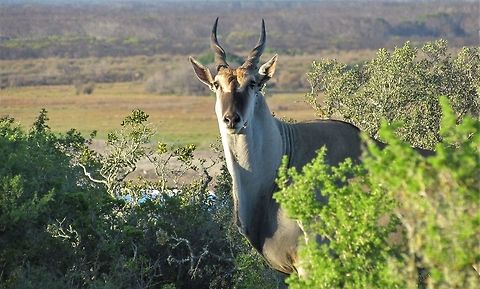
Appearance
Common elands are spiral-horned antelopes. They are sexually dimorphic, with females being smaller than the males. Females weigh 300–600 kg, measure 200–280 cm from the snout to the base of the tail and stand 125–153 cm at the shoulder. Bulls weigh 400–942 kg, are 240–345 cm from the snout to the base of the tail and stand 150–183 cm at the shoulder. The tail is 50–90 cm long. Male elands can weigh up to 1,000 kg.Their coat differs geographically, with elands in northern part of their range having distinctive markings that are absent in the south. Apart from a rough mane, the coat is smooth. Females have a tan coat, while the coats of males are darker, with a bluish-grey tinge. Bulls may also have a series of vertical white stripes on their sides. As males age, their coat becomes more grey. Males also have dense fur on their foreheads and a large dewlap on their throats.
Both sexes have horns with a steady spiral ridge. The horns are visible as small buds in newborns and grow rapidly during the first seven months. The horns of males are thicker and shorter than those of females long and females' are 51–69 centimetres long), and have a tighter spiral. Males use their horns during rutting season to wrestle and butt heads with rivals, while females use their horns to protect their young from predators.
The common eland is the slowest antelope, with a peak speed of 40 kilometres per hour that tires them quickly. However, they can maintain a 22 kilometres per hour trot indefinitely. Elands are capable of jumping up to 2.5 metres from a standing start when startled for young elands). The common eland's life expectancy is generally between 15 and 20 years; in captivity some live up to 25 years.
Eland herds are accompanied by a loud clicking sound that has been subject to considerable speculation. It is believed that the weight of the animal causes the two halves of its hooves to splay apart, and the clicking is the result of the hoof snapping together when the animal raises its leg. The sound carries some distance from a herd, and may be a form of communication.
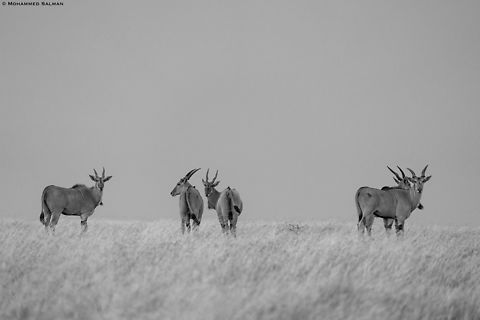
Naming
The scientific name of the common eland is "Taurotragus oryx", composed of three words: "tauros", "tragos" and "oryx". "Tauros" is Greek for a bull or bullock, meaning the same as the Latin "taurus". "Tragos" is Greek for a male goat, referring to the tuft of hair that grows in the eland's ear and its resemblance to a goat's beard. "Oryx" is Latin and Greek for pickaxe, referring to the pointed horns of North African antelopes like the common eland and scimitar-horned oryx.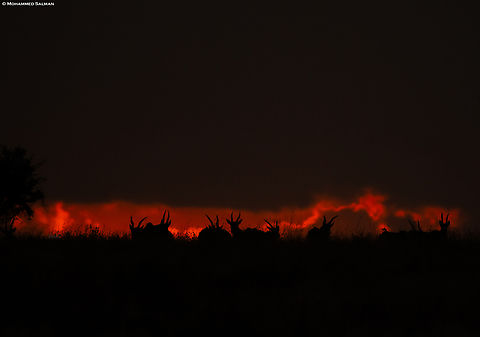
Distribution
Common elands live on the open plains of southern Africa and along the foothills of the great southern African plateau. The species extends north into Ethiopia and most arid zones of South Sudan, west into eastern Angola and Namibia, and south to South Africa. However, there is a low density of elands in Africa due to poaching and human settlement.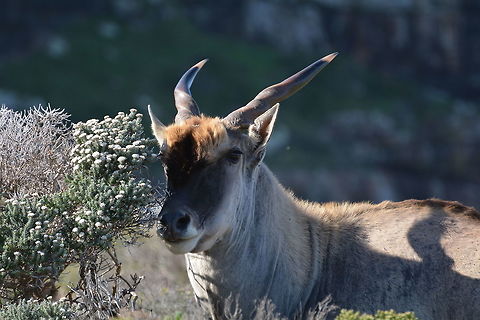
Status
Currently, common elands are not endangered. They are conserved by the United States Endangered Species Act, and regulated in international trade by the Convention on International Trade in Endangered Species.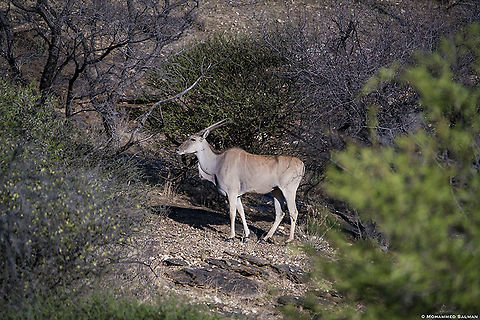
Behavior
Common elands are nomadic and crepuscular. They eat in the morning and evening, rest in shade when hot and remain in sunlight when cold. They are commonly found in herds of up to 500, with individual members remaining in the herd anywhere from several hours to several months. Juveniles and mothers tend to form larger herds, while males may separate into smaller groups or wander individually. During estrus, mainly in the rainy season, groups tend to form more regularly. In southern Africa common elands will often associate with herds of zebras, roan antelopes and oryxes.Common elands communicate via gestures, vocalizations, scent cues and display behaviors. The flehmen response also occurs, primarily in males in response to contact with female urine or genitals. Females will urinate to indicate fertility during the appropriate phase of their estrous cycle, as well as to indicate their lack of fertility when harassed by males. If eland bulls find any of their predators nearby, they will bark and attempt to attract the attention of others by trotting back and forth until the entire herd is conscious of the danger. Some of their main predators include lions, African wild dogs, cheetahs and spotted hyenas. Juvenile elands are more vulnerable than adults to their predators.
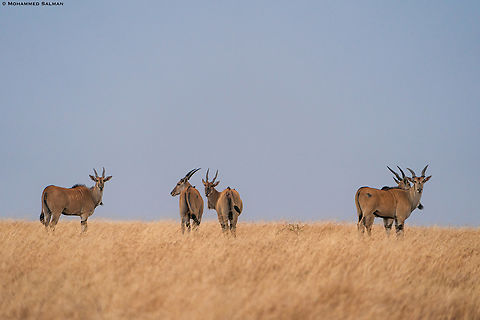
Habitat
Elands prefer to live in semi-arid areas that contain many shrub-like bushes, and often inhabit grasslands, woodlands, sub-desert, bush, and mountaintops with altitudes of about 15,000 ft. Elands do, however, avoid forests, swamps and deserts.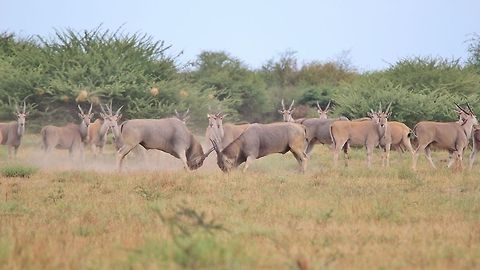
Reproduction
Females are sexually mature at 15–36 months and males at 4–5 years. Mating may occur anytime after reaching sexual maturity, but is mostly seen in the rainy season. In Zambia, young are born in July and August, while elsewhere it is the mating season. Mating begins when elands gather to feed on lush green plains with plentiful grass, and some males and females start mating with each other in separate pairs. Males chase the females to find out if they are in estrus. They also test the female's urine. Usually, a female chooses the most dominant and fit male to mate with. Sometimes she runs away from males trying to mate, causing more attraction. This results in fights between males, in which their hard horns are used. It is 2–4 hours before a female allows a male to mount. Males usually keep close contact with females in the mating period. The dominant male can mate with more than one female. Females have a gestation period of 9 months, and give birth to only one calf each time.Males, females and juveniles each form separate social groups. The male groups are the smallest; the members stay together and search for food or water sources. The female group is much larger and covers greater areas. They travel the grassy plains in wet periods and prefer bushy areas in dry periods. Females have a complex linear hierarchy. The nursery and juvenile group is naturally formed when females give birth to calves. After about 24 hours of the delivery, the mother and calf join this group. The calves start befriending each other and stay back in the nursery group while the mother returns to the female group. The calves leave the nursery group when they are at least two years old and join a male or female group.
References:
Some text fragments are auto parsed from Wikipedia.